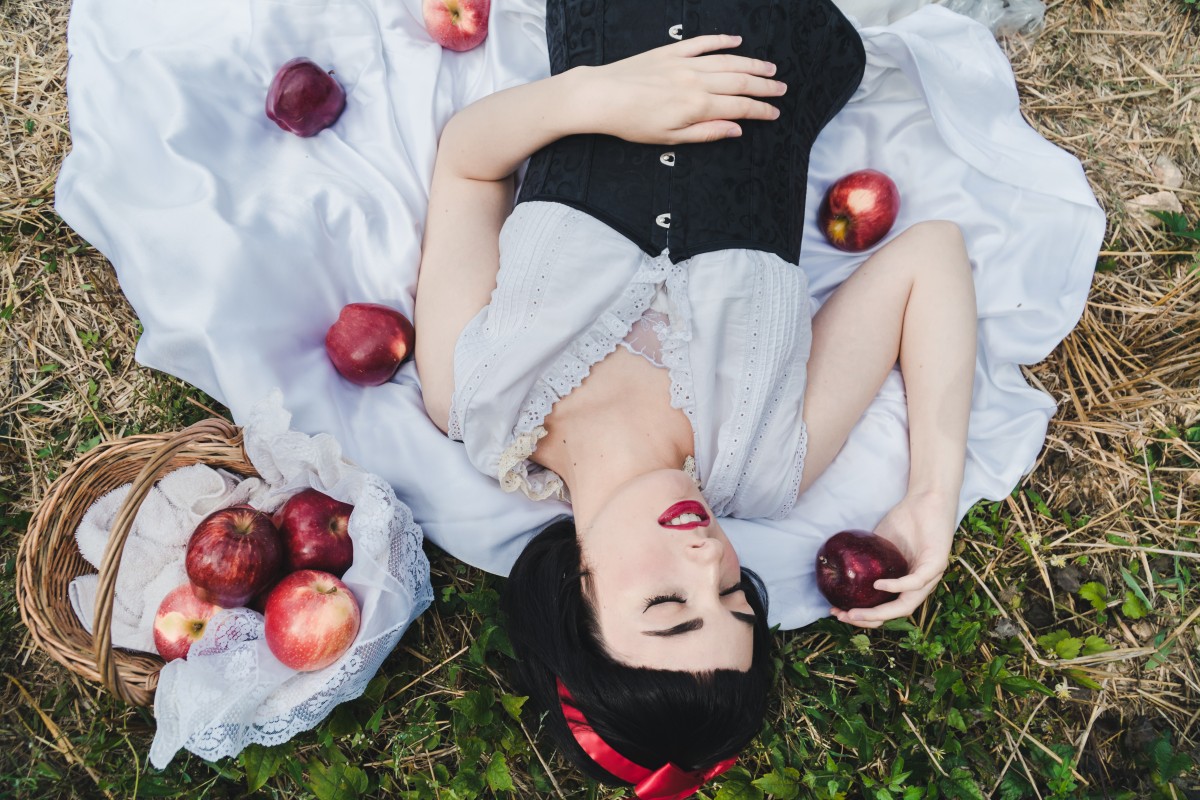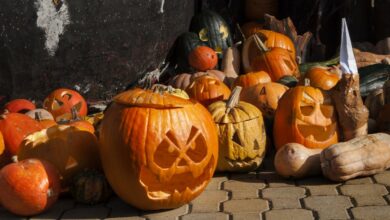Many of the classic Disney animated films come from legends, fairy tales, folk tales, or books–and some of the original stories are not at all the stories you remember from your childhood. Below is a list of Disney’s animated masterpieces featuring princesses that are taken from folklore, and the original (and sometimes rather grisly and strange) versions that inspired them.
The original version of this story, made world-famous by the Brothers Grimm, begins with Snow White’s mother sitting at a window sewing as it snows outside. She pricks her finger with her needle and, upon gazing at her own drop of blood against the snow, wishes for a child with lips as red as blood, skin as white as snow, and hair as black as ebony. The original version also sees the Wicked Queen trying to poison Snow White with a comb, selling her lace bodices that cause her to faint, and, in possibly the most macabre deviation, the Wicked Queen intends to have Snow White’s heart not just to ensure her rival’s death but because she believes she will become immortal if she consumes it. Pretty easy to understand why that didn’t make it into the animated version.
The earliest known version of this tale is the story Rhodopis and comes from about 6 or 7 BC, with the Greek geographer Strabo telling a tale of a Greek courtesan whose life was turned upside down after an eagle snatched her sandal and dropped it at the foot of the King of Egypt. An adaptation of that story then appeared in Italy in the 1600s, and then another version was penned by Charles Perrault in France in 1697. The Perrault version gives Cinderella her name because she would curl up in the ashes of the fireplace to stay warm during winter nights; Disney omit this particular detail despite retaining the title. The Brothers Grimm then tried their hand at an adaptation, and theirs was the most grisly by far and featured the ugly stepsisters literally cutting off their own heels and toes in order to get Cinderella’s slipper to fit.
SLEEPING BEAUTY (1959)
The original tale of Sleeping Beauty may have more in common with an Aldomodovar film than a Disney movie as the selfsame peasant maid is not woken by true love’s kiss as is the case in the animated version. Rather, it is labor pains which awaken her from her cursed slumber. Not only that, but it is not a charming young prince who attempts to wake the princess, but a fully married king who assaults the princess as she sleeps and then lies to his wife about the entire affair. La Bois au Belle Dormant was written by Charles Perrault, and the name of the princess was neither Aurora nor Briar Rose. An earlier version gave her the name Talia.
THE LITTLE MERMAID (1989)
Among the more disturbing original tales is Hans Christian Anderson’s The Little Mermaid, in which the nameless mermaid must endure the pain of walking on knives as well as an inability to vocalize in order to secure her personhood. The prince, upon seeing her, asks her to dance, and she obliges mutely despite excruciating pain. However, the prince marries someone else. She is also nearly manipulated by her sisters into stabbing and killing the prince with an enchanted knife that they procured from the same witch that the little mermaid dealt with in order to become human. However, the little mermaid cannot bring herself to kill the prince, and instead flings herself into the sea, where the celestial spirits reward her by turning her into ether and promising her a return to a soul if she can help mankind for the next 300 years.
BEAUTY AND THE BEAST (1991)
The original written story has been credited to a Gabrielle-Suzanne Barbot de Villeneueve, who claims she heard it told from one young woman to another while on board a ship. It is, if we may say so, maybe even cooler than the animated film. Belle dreams every night of a handsome prince, although she has not met him, and a wise fairy. She is given a magic mirror where she can watch any theatrical performance of her choice (prediction of television, anyone?). In this version, it is a wicked fairy rather than an enchantress who curses the prince to become a beast. The Brothers Grimm also have a version where the prince is an actual lion rather than a mere beast.
ALADDIN (1992)
This may come as a surprise to fans of Disney’s Aladdin, but, despite coming from the collection of stories known as The Arabian Nights, the original story is not set in the Arab world. Rather, it comes from China–and the titular character is not a scruffy street urchin alone in the world save his pet monkey but a lazy boy who lives with his mom. The stories from The Arabian Nights were, interestingly, told to Antoine Galland by a Syrian storyteller, who then translated these stories into French and published them in Paris in the 1700s. No, Agrabah was not in the original story, and was in fact an invention of Disney itself. In some versions of this tale, there is a second genie; in another, a magic ring belonging to an evil sorcerer–and Jasmine’s name was actually Badroulbadour, which refers to the full moon.
THE PRINCESS AND THE FROG (2009)
So this Disney version took inspiration from both the classic fairy tale and a YA novel from 2002 which imagined the princess also turning into a frog. While they both feature a narrative backdrop of a swamp, the titular princess in the novel is named Esmeralda, has a laugh like a donkey’s bray, a magical aunt named Grassina, and a bat named Lil Stinker. The original, older version entitled The Princess and the Frog features a frog who rescues a princess’s golden ball from within a well where she dropped it, promising to return it to her on the condition that she let the frog dine with her and sleep in her bed for three nights. The princess, though she has no intentions of going good on her word, agrees because she loves her golden ball and wants it back. But her father the king learns of her promises and forces her to make good on them. It later turns out that the frog is a prince who was cursed by a witch, who told him that he would never return to his previous human form unless he could get a princess to agree to let him eat at her table and sleep in her bed for three nights. Of course, as is the case in most fairy tales, nobody minds the shock because the prince is handsome.
TANGLED (2010)
In the original version of the Rapunzel tale, a peasant couple is expecting their first child. The woman, heavily pregnant craves one thing and one thing only: rapunzel leaves. Next door to her cottage lives an old and evil witch with a gigantic garden, and the woman sits all day looking over the stone wall into the witch’s garden and dreams about eating them. Finally in her desperation she tells her husband that if he doesn’t steal some rapunzel leaves from the witch she will literally die. Her husband not only believes her, but fulfills her request, which empowers her to make daily demands on a rapunzel supply that he can barely keep up with. Finally the witch finds out, and says she will forgive him if he gives her his unborn child. Unbelievably he agrees to this, and when his daughter is born the witch holds him to his word and takes the daughter away, hiding her in a tall tower. When the witch discovers that a prince has been visiting the teenage Rapunzel in her tower, she pushes the prince out of the window. A bush of thorns breaks his fall, blinding him. Unbeknownst to either Rapunzel or her beloved prince they both wander aimlessly in the desert for years until they find each other and her tears of joy restore his eyesight.
FROZEN (2015)
Disney’s Frozen is probably the adapted animated film that deviates the most from the original folk tale that inspired it. The Snow Queen was written by Hans Christian Anderson in 1844, and in his version the trolls were evil creatures who distorted reality just for the fun of it by way of a magic mirror which amplifies the ugly aspects of things and erases the positive and beautiful. These trolls were so wicked that they hatched a plan to take the mirror up to Heaven and fool some of the angels with it, but on their way skyward they dropped the mirror and it shattered into a million grains of sand. The story then switches to feature a childhood friendship between a little boy and a little girl, which sours when the little boy gets blown with some of the bewitched sand grains from the shattered mirror. Many things follow, none of which are featured in Frozen or Frozen II.






